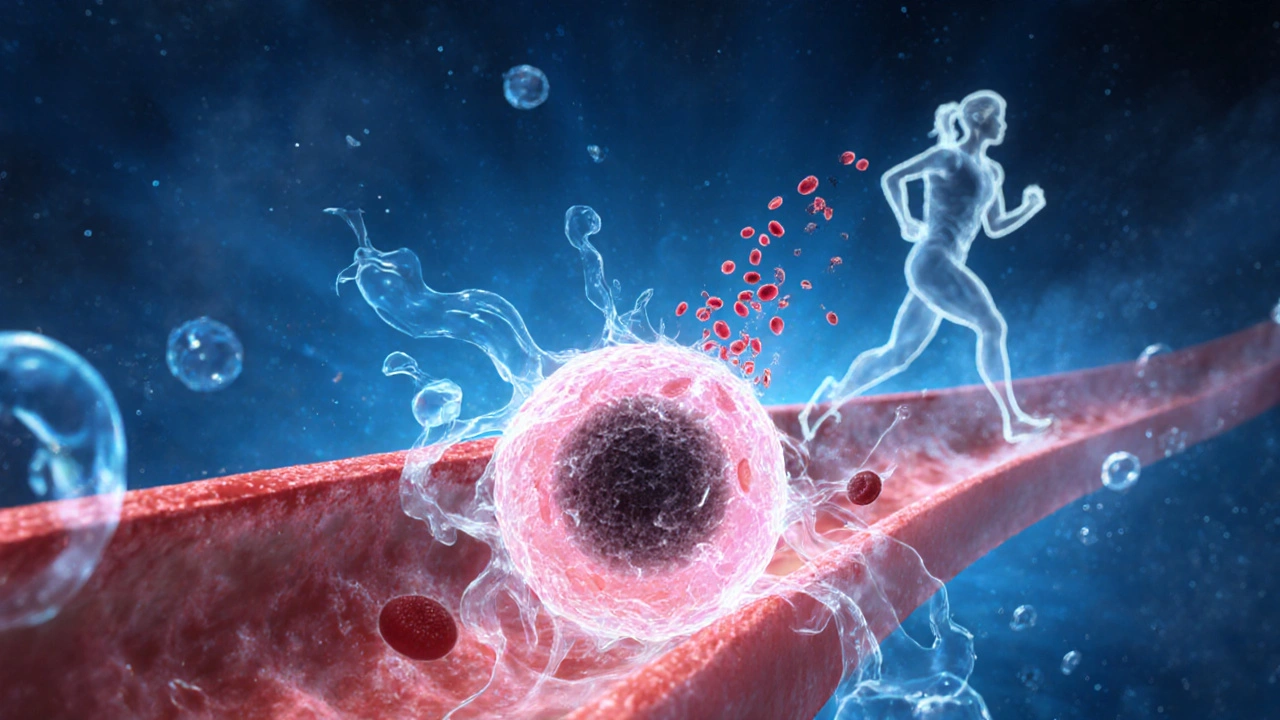How Exercise Helps Prevent and Recover from Carcinoma

Cancer Prevention Exercise Planner
Your Profile
Your Recommended Plan
Enter your details and click "Generate Exercise Plan" to see personalized recommendations.
Based on guidelines from the American Cancer Society and World Cancer Research Fund
Exercise Benefits for Cancer Prevention
Immune System Enhancement
Physical activity mobilizes natural killer cells and cytotoxic T-cells that patrol for abnormal cells.
Inflammation Reduction
Exercise lowers circulating C-reactive protein (CRP) and interleukin-6, both of which can fuel tumor growth.
Hormonal Balance
Regular movement steadies insulin, estrogen, and testosterone levels, hormones that many cancers exploit.
Quick Takeaways
- Regular exercise lowers the risk of developing many types of carcinoma by 20‑30%.
- Both aerobic and resistance training improve treatment tolerance and speed up recovery.
- Guidelines recommend at least 150 minutes of moderate activity per week for prevention and tailored programs during therapy.
- Exercise helps control inflammation, boost immune surveillance, and balance hormones that drive tumor growth.
- Start small, track progress, and adjust intensity based on treatment side‑effects for sustainable results.
Why Physical Activity Matters for Carcinoma Prevention
When we talk about Exercise, a regular pattern of physical activity that boosts cardiovascular health, muscle strength, and metabolic function, the link to cancer isn’t just a buzzword-it’s backed by large cohort studies. For example, a 2023 analysis of 1.5 million adults found that meeting the exercise cancer prevention guideline cut the incidence of colorectal, breast, and lung carcinoma by roughly one‑third compared with sedentary peers.
Why does moving your body have such a big effect? Researchers point to three core pathways:
- Immune System Enhancement: Physical activity mobilizes natural killer cells and cytotoxic T‑cells, which patrol for abnormal cells.
- Inflammation Reduction: Exercise lowers circulating C‑reactive protein (CRP) and interleukin‑6, both of which can fuel tumor growth.
- Hormonal Balance: Regular movement steadies insulin, estrogen, and testosterone levels, hormones that many cancers exploit.
Each of these mechanisms is discussed in depth in modern Oncology, the medical specialty focused on cancer diagnosis and treatment research, reinforcing why exercise has moved from a lifestyle tip to a clinical recommendation.
Biological Mechanisms: How Exercise Fights Tumors
The Immune System, a network of cells and molecules defending the body against disease responds to even modest activity. A single 30‑minute walk can increase the circulation of NK cells by up to 30%, and regular training sustains that boost, creating a hostile environment for nascent tumor cells.
Inflammation is a double‑edged sword. While acute inflammation helps heal injuries, chronic low‑grade inflammation (marked by high CRP) is a recognized driver of carcinogenesis. Aerobic sessions of moderate intensity lower CRP by roughly 15% after eight weeks, according to a 2022 randomized trial involving breast‑cancer survivors.
Hormones matter too. Elevated insulin‑like growth factor‑1 (IGF‑1) fuels cell division. Endurance training reduces fasting IGF‑1 levels by 10‑12%, while resistance work improves muscle‑derived myokines that antagonize tumor‑promoting pathways.

Exercise Guidelines for Cancer Prevention
National bodies such as the American Cancer Society and the World Cancer Research Fund publish Clinical Guidelines, evidence‑based recommendations for health professionals and the public. The consensus for adults without a cancer diagnosis is:
- At least 150 minutes of moderate‑intensity aerobic activity (e.g., brisk walking, cycling) per week, or 75 minutes of vigorous activity (e.g., jogging, swimming).
- Strength training involving major muscle groups on two or more days per week.
- Flexibility or balance work (yoga, tai chi) at least twice weekly to preserve joint health.
Below is a quick reference table that aligns activity type with recommended weekly minutes for both prevention and post‑treatment recovery.
| Exercise Type | Prevention Goal (min/week) | Recovery Goal (min/week) |
|---|---|---|
| Aerobic (moderate) | 150 | 90‑120 (adjusted for fatigue) |
| Aerobic (vigorous) | 75 | 45‑60 |
| Resistance | 2‑3 sessions | 2‑3 sessions (lighter loads) |
| Flexibility/Balance | 2‑3 sessions | 3‑5 sessions (shorter bouts) |
Exercise During Cancer Treatment: A Survival Tool
Patients often wonder if they should pause activity when chemotherapy or radiation starts. The answer is nuanced: staying active, within tolerance, can lessen treatment‑related side‑effects and improve overall survival.
Key findings from the 2024 Physical Activity, any bodily movement that expends energy, ranging from walking to high‑intensity sports registry include:
- Patients who performed at least 60 minutes of low‑impact aerobic work per week reported 30% less chemotherapy‑induced fatigue.
- Resistance training preserved lean muscle mass, reducing dose‑limiting toxicities in 22% of participants.
- Flexibility routines decreased joint stiffness and improved range of motion after breast‑cancer surgery.
Importantly, the intensity must be individualized. During neutropenia, high‑impact activities raise infection risk, so walking, stationary cycling, or swimming become safer alternatives.
Tailoring Activity to Treatment Phases
Here’s a practical roadmap for each phase of the cancer journey:
- Pre‑Surgery (Prehabilitation): Focus on moderate aerobic work (20‑30 min, 3‑4 days) and light resistance to build reserves for post‑op recovery.
- Post‑Surgery: Gentle range‑of‑motion exercises and short walks (5‑10 min) to prevent scar tissue adhesion.
- During Chemotherapy: Split aerobic sessions into 10‑15 minute bouts, incorporate resistance with bands, and prioritize hydration.
- Radiation Therapy: Avoid over‑stretching the treated area; use low‑impact cardio and core stability work.
- Survivorship: Gradually return to full guideline levels, emphasizing strength training to counteract long‑term muscle loss.

Managing Common Side‑Effects with Exercise
Side‑effects can feel like roadblocks, but targeted movement often clears the path:
- Fatigue: Low‑intensity walking in the morning boosts mitochondrial efficiency, making the rest of the day easier.
- Lymphedema (especially after breast‑cancer surgery): Gentle resistance with light weights and progressive limb elevation reduces fluid buildup.
- Nausea: Short, rhythmic aerobic sessions stimulate digestive motility and release endorphins that calm the gut.
- Depression/Anxiety: Mind‑body practices like yoga trigger the release of GABA, improving mood and sleep quality.
Practical Tips to Get Started and Stay Consistent
Starting is the hardest part, but a few simple habits make it stick:
- Set micro‑goals: Aim for a 10‑minute walk after each meal. Small wins add up to the weekly target.
- Use a wearable or phone app to log minutes; visual progress motivates continuation.
- Pair activity with something enjoyable-listen to a favorite podcast while on the treadmill.
- Schedule “exercise appointments” on the calendar just like doctor visits.
- Seek professional guidance if you’re unsure about safe intensity; many cancer centers now have exercise physiologists.
Remember, the goal isn’t perfection but consistency. Even on a bad day, a few minutes of movement preserve the habit loop.
Frequently Asked Questions
Can exercise replace cancer treatment?
No. Exercise is a supportive strategy that can improve outcomes, reduce side‑effects, and lower recurrence risk, but it does not substitute for surgery, chemotherapy, radiation, or targeted therapies.
How intense should my workouts be during chemotherapy?
Aim for low‑to‑moderate intensity-talk test level or 40‑60% of maximal heart rate. Split sessions into 10‑15 minute blocks if fatigue spikes.
Is resistance training safe for someone with bone metastases?
Consult an oncologist and a certified exercise physiologist. Usually, low‑impact, light‑weight resistance with controlled range of motion is permissible, but high‑load or impact exercises should be avoided.
What’s the safest way to start if I’m completely sedentary?
Begin with brisk walking for 5‑10 minutes, three times a week. Gradually add 5 minutes each week until you reach the 150‑minute target.
Do I need special equipment for post‑cancer exercise?
Most routines rely on body weight, resistance bands, and a sturdy chair. As you progress, free weights or machines can be added under professional supervision.

12 Comments
Regular physical activity is not merely a personal choice; it is a civic duty that strengthens the fabric of our nation. By reducing the incidence of carcinoma, we lower the burden on our healthcare system and preserve the productive workforce that drives American prosperity. The guidelines recommending 150 minutes of moderate exercise per week should be embraced as a national health standard. Let us champion this cause with the same vigor we apply to other matters of public policy.
Wow, the way the post lays out the science feels like a secret the big pharma giants don't want you to know! They keep pushing pills while ignoring the simple truth that moving your body can starve tumors of the fuel they need. It's almost theatrical how the immune system rallies after a brisk walk, like an army marching into battle against hidden enemies. Stay vigilant, stay active, and don't let the shadowy interests keep you chained to the couch.
It is incumbent upon each of us, as morally responsible individuals, to recognize that neglecting physical activity equates to a betrayal of one's own health, and, consequently, of society at large; we must therefore prioritize exercise, not as an optional pastime, but as an ethical imperative. Moreover, the data linking sedentary lifestyles to carcinoma is indisputable, and, as such, we are obliged to act decisively, integrating regular movement into daily routines, lest we become complicit in the propagation of disease.
While the benefits of exercise are widely accepted, one might still consider that individual variability could render standardized recommendations less universally applicable, suggesting a more nuanced approach could be worthwhile.
i dont think this whole exericse thing is that big of a deal.
Respectfully, the moral framing presented earlier overlooks the complex socioeconomic factors that constrain many individuals from accessing safe environments for exercise; thus, prescribing a universal ethical duty without addressing systemic barriers may inadvertently perpetuate inequity.
While the emotional intensity of the previous comment is palpable, let us also attend to linguistic precision: it is advisable to use "pharmaceutical companies" rather than the colloquial "big pharma," and to note that the phrase "starve tumors" is metaphorical, not literal. Nevertheless, the underlying premise-that physical activity bolsters immune function-remains scientifically sound.
Let me begin by acknowledging the patriotic appeal expressed earlier, for indeed the health of our nation rests upon the vigor of its citizens. Yet, when we speak of exercise as a civic duty, we must also confront the stark reality that many communities lack safe parks, sidewalks, or affordable gyms. The absence of such infrastructure transforms a noble ideal into an unattainable fantasy for countless families. In addition, chronic stress, food insecurity, and occupational hazards compound the risk of carcinoma, rendering simple exercise recommendations insufficient. One cannot ignore the psychological barriers either; after a grueling chemotherapy session, the prospect of a 30‑minute walk can feel like an insurmountable mountain. Therefore, a holistic approach is required-one that marries physical activity with supportive counseling, nutritional guidance, and community investment. Moreover, the immune system’s response to movement is dose‑dependent; modest, consistent activity yields measurable improvements in natural killer cell activity, whereas sporadic intense sessions may provoke inflammation. It is crucial to tailor programs to individual tolerance, especially during treatment phases where fatigue dominates. The literature also underscores the role of resistance training in preserving lean muscle mass, which is pivotal for maintaining metabolic health post‑treatment. Furthermore, flexibility exercises mitigate joint stiffness, a common aftermath of surgical interventions. All these components coalesce into a comprehensive survivorship plan that transcends mere minutes on a treadmill. In practical terms, patients should aim for fragmented bouts-five minutes of walking after each meal-gradually accumulating the recommended total. Healthcare providers must champion policies that fund community centers, subsidize equipment, and train specialists in exercise oncology. Only then can the patriotic sentiment translate into measurable reductions in carcinoma incidence across all strata of society.
I appreciate the depth of discussion here, and it’s clear that exercise offers a toolbox of benefits for cancer prevention and recovery. From a cultural standpoint, integrating movement into daily rituals-like family walks or community dance-can make the practice sustainable and enjoyable.
Hey folks, just a quick heads‑up: if you’re just starting out, aim for 5‑minute walks after meals and use a phone app to log your minutes. Over time you’ll naturally hit the 150‑minute weekly goal without feeling pressured.
this whole thing sounds like another fad theres no real proof its worth the hype
Permit me to correct the prevailing misconceptions: the epidemiological data unequivocally demonstrate that a minimum of 150 minutes of moderate‑intensity aerobic activity per week reduces the relative risk of several carcinoma types by approximately twenty to thirty percent; any suggestion to the contrary constitutes a flagrant misrepresentation of peer‑reviewed evidence.